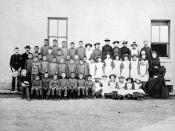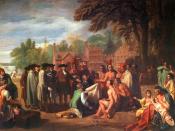The Indian Act of 1876 and many of its amending statutes contained sections that were discriminatory towards Canadian Native Indians, and that legalized suppression of Indian customs and traditions. In this paper, I will examine how one section of the Act, the one relating to residential schools, contributed to the genocide of Indian culture.
Ever since the first Europeans set foot on Canadian soil in the 15th century, they have thought their culture and way of life was superior to that of the Native North Americans. Initially the Europeans relied upon the Indians to show them how to travel and survive in the wilds of Canada. They also were dependent on Indians as trading partners and as military allies. However, as more settlers arrived and the Europeans no longer needed the Indians, their sense of superiority took hold. The settlers began to take over Indian agricultural land and deplete their subsistence resources.
The Royal Proclamation of 1763, which gave the imperial government authority to govern the Indians, was intended mainly to protect them and their lands from unscrupulous white settlers. However, British policy changed and their objective became to assimilate Indians into Canadian society. With their ethnocentric impression in mind, the Europeans tried to convert the "savages" to the "proper" European way of life through whatever means possible. If these old Europeans were alive on July 1, 1920 and April 10, 1930, they would have stood proudly by the government and the Indian Act it had created and amended on these respective dates. The purpose of this was plainly evident.
"Our object is to continue until there is not a single Indian in Canada that has not been absorbed into the body politic and there is no Indian question, and no Indian department, that is the whole object of...


